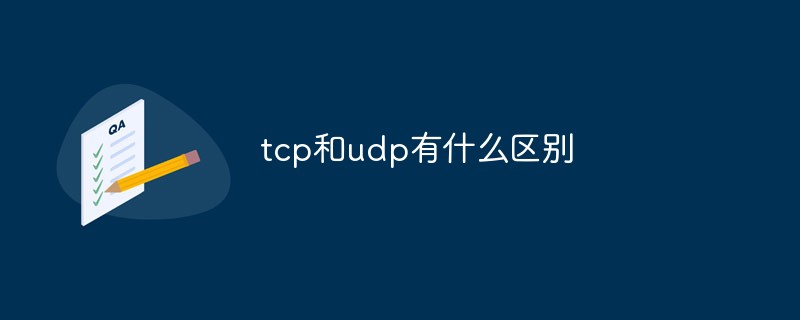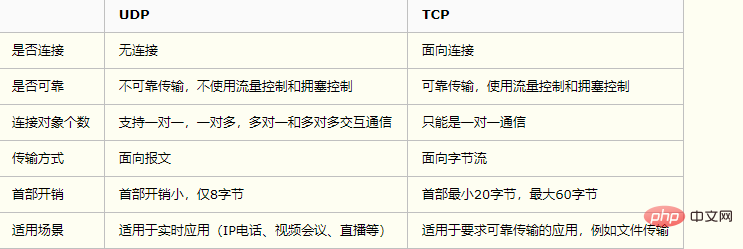Home >Common Problem >What is the difference between tcp and udp
The differences between tcp and udp are: 1. udp is connectionless, tcp is connection-oriented; 2. udp is unreliable transmission, tcp is reliable transmission; 3. udp is message transmission-oriented, tcp It is oriented to byte stream transmission.

Comparison:
(Learning video recommendation: java video tutorial)

UDP
The full name of UDP protocol is User Datagram Protocol. It is used to process data packets like TCP protocol in the network. It is a connectionless protocol. In the OSI model, the fourth layer - the transport layer, is the upper layer of the IP protocol. UDP has the disadvantage of not providing data packet grouping, assembly, and inability to sort data packets. That is to say, after a message is sent, it is impossible to know whether it has arrived safely and completely.
It has the following characteristics:
1. Connectionless oriented
First of all, UDP does not need to perform a three-way handshake to establish a connection before sending data like TCP. Send data to start sending. And it is only a porter of data packets and will not perform any splitting or splicing operations on data packets.
Specifically:
At the sending end, the application layer passes the data to the UDP protocol of the transport layer. UDP will only add a UDP header to the data. Under the UDP protocol, then Passed to the network layer. At the receiving end, the network layer passes the data to the transport layer. UDP only removes the IP header and passes it to the application layer without any splicing operation.
2. There are unicast and multicast , broadcast function
UDP not only supports one-to-one transmission, but also supports one-to-many, many-to-many, and many-to-one. In other words, UDP provides unicast, multicast, and broadcast. Function.
3. UDP is message-oriented
The sender's UDP delivers the message to the application program. After adding the header, it is delivered down to the IP layer. UDP neither merges nor splits the packets handed over by the application layer, but retains the boundaries of these packets. Therefore, the application must choose a message of appropriate size
4. Unreliability
First of all, unreliability is reflected in the lack of connection. There is no need to establish a connection for communication. You can send whenever you want. Such a situation is certainly unreliable.
And any data received will be transferred, and the data will not be backed up. When sending data, it will not care whether the other party has received the data correctly.
Furthermore, the network environment is good and bad, but UDP will always send data at a constant speed because there is no congestion control. Even if the network conditions are not good, the sending rate will not be adjusted. The disadvantage of this implementation is that it may cause packet loss when the network conditions are not good, but the advantages are also obvious. In some scenarios with high real-time requirements (such as conference calls), UDP needs to be used instead of TCP.
5. The header overhead is small and it is very efficient when transmitting data messages.
TCP
When one computer wants to communicate with another computer, the communication between the two computers needs to be smooth and reliable so that data can be sent and received correctly. For example, when you want to view a web page or check your email, you want to see the web page completely and in order without losing any content. When you download a file, you hope to get the complete file, not just a part of the file, because if the data is lost or out of order, it is not the result you want, so TCP is used.
The full name of TCP protocol is Transmission Control Protocol. It is a connection-oriented, reliable, byte stream-based transport layer communication protocol, defined by RFC 793 of IETF. TCP is a connection-oriented, reliable streaming protocol. A stream refers to an uninterrupted data structure. You can think of it like water flowing in a drainpipe.
1. TCP connection process
First handshake
The client sends a connection request segment to the server. This message segment contains its own data communication initial sequence number. After the request is sent, the client enters the SYN-SENT state.
Second handshake
After the server receives the connection request segment, if it agrees to the connection, it will send a response, which will also include its own initial sequence number for data communication. After the transmission is completed, it enters the SYN-RECEIVED state.
Third handshake
When the client receives the connection approval response, it also sends a confirmation message to the server. After the client sends this message segment, it enters the ESTABLISHED state. After the server receives this response, it also enters the ESTABLISHED state. At this time, the connection is successfully established.
You may have a question here: Why does TCP require three handshakes to establish a connection, instead of two? This is because this is to prevent invalid connection request segments from being received by the server, resulting in errors.
2. TCP disconnection
TCP is full-duplex, and both ends need to send FIN and ACK when disconnecting.
First handshake
If client A thinks that the data transmission is completed, it needs to send a connection release request to server B.
Second handshake
B After receiving the connection release request, it will tell the application layer to release the TCP link. Then an ACK packet will be sent and the CLOSE_WAIT state will be entered. This indicates that the connection from A to B has been released and the data sent by A will no longer be received. But because the TCP connection is bidirectional, B can still send data to A.
The third handshake
If there is still unfinished data at this time, B will continue to send. After completion, it will send a connection release request to A, and then B will enter the LAST-ACK state.
The fourth handshake
After A receives the release request, it sends a confirmation response to B. At this time, A enters the TIME-WAIT state. This state will last for 2MSL (maximum segment lifetime, which refers to the time the message segment survives in the network, and will be discarded after timeout). If there is no resend request from B within this time period, it will enter the CLOSED state. When B receives the confirmation response, it also enters the CLOSED state.
3. Characteristics of TCP protocol
Connection-oriented
Connection-oriented means that a connection must be established at both ends before sending data. The method of establishing a connection is the "three-way handshake", which can establish a reliable connection. Establishing a connection lays the foundation for reliable transmission of data.
Only supports unicast transmission
Each TCP transmission connection can only have two endpoints, can only perform point-to-point data transmission, and does not support multicast and broadcast transmission methods.
Oriented to byte streams
TCP does not transmit messages independently like UDP, but transmits them in a byte stream without retaining message boundaries.
Reliable transmission
For reliable transmission, determining packet loss and error depends on the TCP segment number and confirmation number. In order to ensure the reliability of message transmission, TCP gives each packet a sequence number. At the same time, the sequence number also ensures that the packets transmitted to the receiving end entity are received in order. The receiving entity then sends back a corresponding acknowledgment (ACK) for the successfully received bytes; if the sending entity does not receive the acknowledgment within a reasonable round trip delay (RTT), then the corresponding data (assumed to be lost) will be retransmitted.
Provide congestion control
When the network is congested, TCP can reduce the rate and quantity of data injected into the network and alleviate congestion
TCP provides full-duplex communication
TCP allows applications on both sides of the communication to send data at any time, because both ends of the TCP connection have caches to temporarily store data for two-way communication. Of course, TCP can send a data segment immediately, or it can cache it for a period of time to send more data segments at once (the maximum data segment size depends on the MSS)
Related recommendations: php training
The above is the detailed content of What is the difference between tcp and udp. For more information, please follow other related articles on the PHP Chinese website!